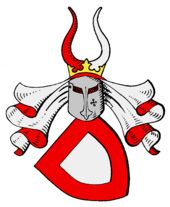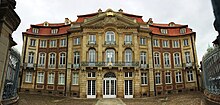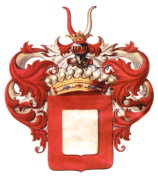Droste to Vischering
Droste zu Vischering is the name of a Westphalian noble family . The Droste zu Vischering belong to the primeval nobility of the Principality of Münster and are among the most important families in the Münsterland. Counts and baronial branches of the family still exist today.
The Droste zu Senden are of the same tribe and coat of arms as those of Vischering. The barons Droste zu Senden also exist to this day.
However, there is no tribal relationship to other Westphalian families with the name Droste, such as the Droste zu Erwitte and the Droste zu Hülshoff .
history
origin
The von Wulfheim family was originally called . The family first appears in a document in 1170 with the episcopal-Münster Drosten Albertus dapifer . It is possibly identical to the stewardess of the bishop of Münster Albrecht von Wulfheim , who took part in the princes' assembly in Goslar for Münster in 1173 and with which the family series begins. The von Wulfheim family called themselves Wulfen bei Lembeck after their property .
The Truchsess , usually called Drost in northern Germany , was a high administrative officer of a prince (here the bishops of Münster as rulers in the monastery of Münster ) and as such was responsible for the administration of prince-bishop's goods and lands.
In 1271, Gerhard von der Mark , Bishop of Münster, built Vischering Castle in order to consolidate his claims to Lüdinghausen after disputes with the Wolf von Lüdinghausen family . The rebellious Lüdinghausen brothers had built Wolfsberg Castle a little south of Lüdinghausen Castle, probably without the consent of the bishop , and so shortly before 1271 Bishop Gerhard had Vischering Castle built as a fortress on an approximately 80-meter-long sand island in a Steverarm in order to preserve the sovereign rights of the diocese to secure. With a document dated July 25, 1271 , he enfeoffed his Ministerial Albert (Albrecht) III. von Wulfheim (1268–1315), Drost von Dülmen , with the office of Drosten at Vischering Castle. From 1309 onwards, members of the family called themselves Droste zu Vischering for the first time and made the new official title their family name.
Expansion and possessions
The two sons of Bernhard Droste zu Vischering († 1331), Amtsdrost at Vischering Castle and since 1322 also Mr. Kakesbeck Castle (owned by the family until 1384 and again from 1738 to the mid-20th century), Heinrich and Albrecht , founded two lines:
Send Droste
Alexander (1357–1401), the son of Albrecht, married Kunigunde, the heir to the family von Senden ; Through this marriage he received their headquarters, Schloss Senden in the Münsterland, along with other goods, and founded the baronial line of Droste zu Senden , which is still based in Senden . The son of Alexander and Kunigunde, Ludeke Droste (1405–1466), built the Senden Palace, which was later expanded many times, as a permanent house in the form of a moated castle. His son Sander II Droste zu Senden (1448–1502) expanded the manor house in its current form. In 1680 Gut Patzlar and 1713 Gut Isingholt were added through inheritance, and in 1729 Gut Venhaus through purchase. In 1957 the barons Droste zu Senden sold the Senden Castle, which had been damaged by the English occupation, and moved into the nearby Wulfshoek forester's house. The Senden'sche Hof in Münster still belongs to the line to this day .
Droste to Vischering
Heinrich was the progenitor of the later barons and counts Droste zu Vischering , who are still based at Vischering Castle, Darfeld Castle and the Erbdrostenhof in Münster.
In 1414 the brothers Heinrich and Johann Droste zu Vischering shared ownership of Vischering Castle. During the Münster collegiate feud from 1450 to 1457, parts of the castle were sold or pledged. Gerhard Morrien was able to acquire part of it, but in 1473, through the marriage of his daughter to Heidenreich von Droste zu Vischering, he returned to Droste zu Vischering's possession. House Beck , near Recklinghausen , owned the Droste zu Vischering since 1481. There was probably a relationship to the Droste zu Beck , who appeared at the end of the 15th century.
From 1549 to 1803 the Droste zu Vischering family provided the Drosten of the offices of Ahaus and Horstmar, which covered large parts of the western Münsterland .
Johann Droste the Elder was a member of the Cologne Cathedral Chapter and in 1583 played a key role in the deposition of the Archbishop of Cologne, Gebhard Truchseß von Waldburg , who had converted to Protestantism . In the Münster monastery, too, the members of the family proved to be followers of the Catholic faith: Heidenreich Droste V. (* 1540; † 1620) and Heidenreich Droste VI. (* 1580; † 1643) were loyal supporters of the bishops Ernst of Bavaria and Ferdinand of Bavaria , to whom the nobility of the territory was otherwise in predominantly denominational opposition. Many Herr Droste zu Vischering achieved a remarkable rise in the cathedral chapter of Münster: Heinrich (* 1540, † 1620) rose to the position of cathedral scholaster and governor, Adolf Heinrich († 1650) to the provost of the cathedral . Gottfried († 1652) and Adolf Heidenreich († 1724) achieved the office of cathedral cantor , Goswin († 1680) the office of cathedral bursar ; Adolf Heinrich († 1666) remained a simple canon . Also Heidenreich Ludwig († 1723) rose to the Domscholaster. However, all of the above had been given several preliminaries and still had cathedral praise in Osnabrück and / or Paderborn . The Knight of Malta Gottfried Droste zu Vischering (Grand Prior) was Commander of the Coming Colmar and Soultz-Haut-Rhin in distant Alsace until 1683, as well as Grand Prior and Prince of Heitersheim . Even during the 18th century, other members of the family achieved high ecclesiastical dignity in the Westphalian cathedral and monastery.

In 1680 the dombursar Goswin Droste zu Vischering acquired the moated Darfeld castle , which after his death in 1690 fell to the ancestral line of Vischering, which soon made it their headquarters. To this day, Darfeld Castle has remained the residence of the respective hereditary deaths. In 1707 Maximilian Heidenreich married Maria Antonia / Gaudentia Wilhelmina Josefa zu Büren and Ringelstein von Schenking zu Beveren and Asbeck (1687–1718), who brought her mother Antoinette's extensive estates into the marriage, including Haus Vorhelm and Haus Bevern.
Anna Brigitta Droste zu Vischering, a daughter of Maximilian Heidenreich (1684–1751), married Heinrich Johann I Droste zu Hülshoff from the Droste zu Hülshoff family, who had not been related until then , in 1729 . a. the mother of the German Order Commander and Governor of Münster Heinrich-Johann von Droste zu Hülshoff , and a great-grandmother of the poet Annette von Droste-Hülshoff .
In the second half of the 18th century, Clemens August Maria Droste zu Vischering , Erbdrost zu Münster, was married to Sophie Alexandrine von Droste zu Erwitte , from the Füchten family. Their marriage had two daughters and seven sons: Kaspar Maximilian (* 1770; † 1846) was Bishop of Münster and Canon of Halberstadt ; Clemens August (* 1773; † 1845) became Archbishop of Cologne in 1838; Franz was canon of Münster and Hildesheim as well as theological author; Max Heidenreich was married to Regina Freiin von und zu Padberg , heiress of the Padberg possessions in the Brilon district , and founded the Droste von Vischering-Padberg line, based in Padberg-Unterhaus and, since 1878, at Padberg Castle .
Adolf Heidenreich († 1826), heir to the Droste-Vischering family estate, had the Erbdrostenhof in Münster built by Johann Conrad Schlaun from 1753 to 1757 ; His first marriage was to a Countess von Merveldt and, after her death, his second marriage to Maria Caroline von Nesselrode-Reichenstein . Count Maximilian came from the first marriage and Count Felix from the second marriage. Both continue the trunk in an older and a younger line (see below: Droste-Nesselrode) .
The following goods were (or are) owned by the Droste zu Vischering line:
Vischering Castle (since 1271), Darfeld Castle (since 1680), Lütkenbeck House (since the end of the 17th century), Bevern House (since 1707), Asbeck House (since 1731), the Erbdrostenhof in Münster (since 1753), Vorhelm House (1707 to 1974), Haus Holtwick (1600–1995), Burg Kakesbeck (1322 to 1384 and again from 1738 to the mid-20th century), Haus Rockel near Darfeld (1817–2000), Haus Visbeck (1656-20th century .), House Weersche in Osterwick (up to 20th century), House Vehoff in Handorf (Münster) , House Mengede (from 1765, settled as Droste-zu-Vischering-Siedlung in Dortmund) and Langen .
The younger line Droste-Nesselrode (see below) inherited the Reichenstein rule in 1824 and owned Herten Castle until 1974 and the Merten Monastery from 1909 ; to this day it is resident at Burg Herrnstein and Burg Merten an der Sieg.
In the Kingdom of Hanover were Brandlecht , Calden Hoff, Haselünne and Lengerich owned or part-owned by the family. In the Kingdom of the Netherlands , the line to Saesfeld was owned.
Status surveys
Heidenreich Droste zu Vischering, Herr auf Vischering, Erbdrost of the Diocese of Münster and Drost zu Horstmar and Ahaus , was raised to the baron status of Vienna on January 21, 1670 .
On October 30, 1826, Adolph Heidenreich received Baron Drost zu Vischering, Fideikommissherr on Vischering and Erbdrost of the Principality of Münster, from King Friedrich Wilhelm III. at Berlin the Prussian counts . In 1840 the Prussian King confirmed the hereditary positions as titles for the families concerned, but at that time they no longer had an actual official function.
Inheritance
Droste-Nesselrode
Count Adolph Heidenreich's younger son Felix was appointed by his maternal grandfather, Johann Franz Joseph von Nesselrode-Reichenstein († 1824), as a universal heir and, according to a testamentary provision and royal confirmation (October 4, 1826), added his name and coat of arms to the now extinct Counts of Nesselrode-Reichenstein added. He founded the line of Count Droste zu Vischering von Nesselrode-Reichenstein , still resident at Burg Herrnstein and Burg Merten an der Sieg.
Herrnstein Castle , Rhein-Sieg district
Brenken-Droste
Georg Ferdinand (* 1941), fifth son of Georg Graf Droste zu Vischering, Erbdroste, and Clarissa nee Freiin von und zu Brenken, was adopted by his uncle Franz Josef Freiherr von und zu Brenken in 1946 and later inherited his property at Erpernburg Castle near Büren in the Brenken district .
coat of arms
The family coat of arms shows a small silver shield in red. On the crowned helmet two buffalo horns , the right one red and the left one silver. The helmet covers are red-silver.
Coat of arms graphic by Otto Hupp in the Munich calendar of 1901
Significant people
- Adolf Heidenreich Droste zu Vischering (cathedral cantor) (before 1677–1724), cathedral cantor in the Prince Diocese of Münster
- Adolf Heidenreich Droste zu Vischering (Canon) (1699–1747), Canon in Münster, Osnabrück and Minden
- Adolf Heidenreich Droste zu Vischering (Drost, 1715) (1715–1776), Erbdroste and Amtdroste in the offices of Ahaus and Horstmar
- Adolf Heidenreich Droste zu Vischering (Drost, 1769) (1769–1826), Droste in the offices of Horstmar and Ahaus and builder of the Erbdrostenhof
- Adolf Heinrich Droste zu Vischering (before 1620–1650), provost of the cathedral in the prince-bishopric of Münster
- Caspar Maximilian Droste zu Vischering-Padberg (* 1808, † 1887), district administrator of the Brilon district and Prussian member of parliament
- Clemens August Droste zu Vischering (1773–1845), German archbishop
- Clemens August Droste zu Vischering (Canon) (1724–1762), Canon in Münster
- Clemens August Maria Droste zu Vischering (1742–1790), official droste in Ahaus and Horstmar
- Clemens Heidenreich Droste zu Vischering (1832–1923), German politician (Center Party) and landowner
- Christoph Heidenreich Droste zu Vischering (* 1652; † 1723), official Droste in Ahaus and Horstmar
- Dietrich Droste zu Vischering called Manenschyn († 1465), provost of the cathedral in the Principality of Münster
- Felix Graf von Droste zu Vischering (1808–1865), landowner, member of the Prussian manor house from 1858–1865
- Ferdinand Gottfried Droste zu Vischering , canon in Münster and Osnabrück
- Franz Otto von Droste zu Vischering (* 1771; † 1826), Catholic theologian and publicist
- Goswin Droste zu Vischering (* 1612; † 1680), Dombursar in Münster
- Gottfried Droste zu Vischering (* 1579; † 1652), cathedral cantor and cathedral bursar in Münster
- Gottfried Droste zu Vischering (Grand Prior) († 1683), Grand Prior of the German Order of St. John
- Heidenreich Droste zu Vischering (Drost, 1508) (1508–1588), official Droste in Ahaus and Horstmar
- Heidenreich Droste zu Vischering (Drost, 1540) (1540–1622), official Droste in Ahaus and Horstmar
- Heidenreich Droste zu Vischering (after 1540-1620), cathedral scholaster in Münster, see Heinrich Droste zu Vischering
- Heidenreich Droste zu Vischering (Drost, 1580) (1580–1643), official Droste in Ahaus and Horstmar
- Heidenreich Droste zu Vischering (Drost, 1616) (1616–1678), Amtsdroste in Ahaus and Horstmar
- Heidenreich Ludwig Droste zu Vischering (before 1678–1723), cathedral scholaster in Münster
- Heidenreich Matthias Droste zu Vischering (1699–1739), Chapter Vicar and Privy Councilor
- Hermann Droste zu Vischering von Nesselrode-Reichenstein (1837–1904), politician and landowner
- Hermann Droste zu Vischering (* 15th century; † 16th century), canon in Münster
- Elisabeth Droste zu Senden († 1613), abbess at Nottuln Abbey
- Felix Droste Vischering zu Nesselrode-Reichenstein (1808–1865), landowner and member of the Prussian manor house
- Jobst Gottfried Droste zu Vischering († 1729), canon in Münster
- Jobst Moritz Droste zu Senden (* 1666; † 1754), from 1716 to 1754 Landkomtur of the Koblenz Chamber of Commerce of the Teutonic Order
- Johann Bernhard Droste zu Senden (1658–1713), canon in Münster and Speyer and assessor of the Landscape Penny Chamber
- Johann Ferdinand Droste zu Senden (1684–1723), treasurer in the prince-bishopric of Mäünster
- Johann Karl Droste zu Senden (1692–1761), canon in Münster and royal district president
- Josef Freiherr von Droste zu Vischering (* 1784, † 1845), Imperial and Royal Field Marshal Lieutenant, Chief Chamberlain of Archduke Ferdinand Carl Viktor
- Kaspar Maximilian Droste zu Vischering (* 1770; † 1846), from 1826 to 1846 Bishop of Münster
- Liane von Droste (* 1959), German journalist and book author
- Maximilian Heidenreich Droste zu Vischering (* 1684; † 1751), official droste in Ahaus and Horstmar
- Maximilian Heinrich Droste zu Vischering (1749–1801), canon in Münster
- Maximilian Droste zu Vischering-Padberg (* 1781; † 1845), lawyer and district administrator of the Brilon district; Father of Caspar Maximilian Droste zu Vischering-Padberg
- Mary of the Divine Heart (* 1863; † 1899), beatified on November 1, 1975 by Pope Paul VI.
- Mauritz Dietrich Anton Droste zu Senden (1683–1723), canon in Münster and Paderborn
literature
- Ernst Heinrich Kneschke : New general German nobility lexicon . Volume 2, Friedrich Voigt's Buchhandlung, Leipzig 1860, pages 586-588. ( Digitized version ).
- Editor: Droste zu Vischering, Barons von. In: New German Biography (NDB). Volume 4, Duncker & Humblot, Berlin 1959, ISBN 3-428-00185-0 , p. 133 ( digitized version ).
- Leopold von Zedlitz-Neukirch : New Prussian Adelslexicon . Volume 1, Reichenbach Brothers, Leipzig 1836, pages 444-446. ( Digitized version )
- Genealogical manual of the nobility , Adelslexikon Volume III, Volume 61 of the complete series, CA Starke Verlag , Limburg (Lahn) 1975, ISSN 0435-2408
- Bastian Gillner: Free Lords - Free Religion. The nobility of the Oberstift Münster between denominational conflict and state consolidation 1500-1700. (Westphalia in the pre-modern era, Volume 8), Aschendorff, Münster 2011; ISBN 978-3402150504 .
- Clemens Heitmann: The ancestors of the blessed sister Maria geb. Countess Droste zu Vischering. Dinklage 1978.
- Helmut Richtering : House and glory Vischering. The historical everyday life of a knight's seat in the Münsterland and its catchment area. in: Vischering Castle. Festschrift for the opening of the folklore department of the Münsterland Museum Burg Vischering in the restored Bauhaus on August 31, 1984. (= contributions to regional and folklore of the Coesfeld district 20), Coesfeld 1984, pp. 9–30.
- Peter Ilisch : The income of the Vischering house as landlords in the 16th and 17th centuries. History sheets of the district of Coesfeld 38, 2013, pp. 1–14.
Web links
- History of Vischering Castle in www.burgenwelt.de
- Document requests from the Darfeld archive, seat of the Droste family in Vischering / digital Westphalian document database (DWUD)
- Coat of arms of the Droste zu Vischering family in Johann Siebmacher's coat of arms book around 1605
- Droste to Vischering . In: Heinrich August Pierer , Julius Löbe (Hrsg.): Universal Lexicon of the Present and the Past . 4th edition. tape 5 . Altenburg 1858, p. 345-346 ( zeno.org ).
- Coat of arms of Droste zu Vischering , coat of arms of Count Droste zu Vischering and coat of arms of Count Droste zu Vischering von Nesselrode-Reichenstein in the register of arms of the Westphalian nobility
Individual evidence
- ↑ Westfälisches Urkundenbuch, Vol. 2, No. 344
- ↑ The history of Senden Castle ( Memento from June 25, 2010 in the Internet Archive ) (History of the family and the Senden Castle)














